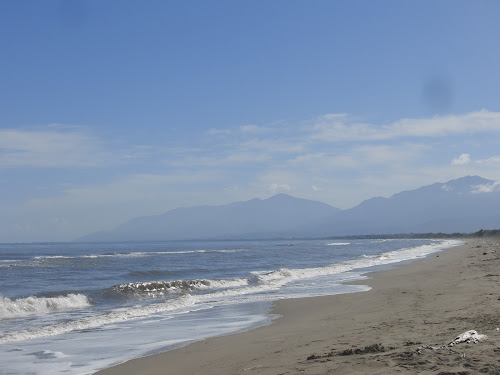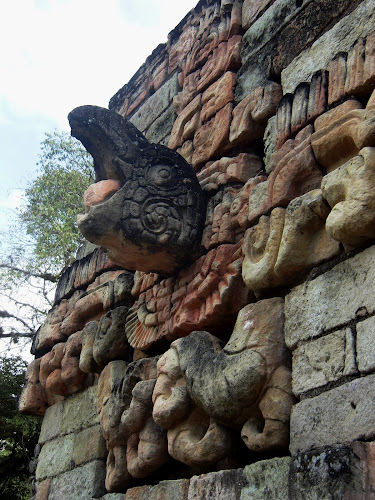To get to Refugio Silvestre Cuero y Salado, you take a bus from the bustling town of La Ceiba to the tiny village of La Union, then you hop on a 2-car mini-train (in Spanish, "trencito") that used to be used for hauling pineapples. It's a 45 minute ride through pineapple and palm plantations to the piece of land that was donated by Standard Fruit to make a wildlife refuge.
On our trencito we were joined by a group of families with small children, and two heavily armed members of the Honduran navy. It turns out Cuero y Salado is not just a national wildlife refuge, but also a small military outpost.

A guy in Las Mangas had called ahead for us to confirm that the refuge had a place to stay, and they said yes. We didn't think to ask what the accommodations were: our guidebook described a small guesthouse with several rooms. When we got there, the guesthouse consisted of, "we'll lend you a tent and pitch it for you right between the visitor's center and the building where all the military guys are staying." We chalked this up as an opportunity to hear the howler monkeys better at dawn.
Our man in Las Mangas was an enthusiastic birder and had recommended a specific guide at Cuero y Salado. Once we were moved into our tent, we headed out with him for a two-hour canoe tour of the mangrove canals, just before dusk.Then we went back out with him at dawn. We saw lots of birds, and both howler and white-faced monkeys.
After a couple of guided tours we were itching to get out in our own canoe. Apparently this is unheard of and completely against official policy at Cuero y Salado. (Our guidebook had said you could rent a canoe...we came to dislike Lonely Planet on this trip.) Matt harangued an ecotourism intern at the park until he talked his boss into letting us go out on our own. We probably didn't see as many birds on our own as we did with the professional, but we messed around seeing how close we could get to bats without spooking them...
and stopped to smell the flowers,

and tried unsuccessfully to take pictures of blue morpho butterflies with their wings open.
The highlight of our solo canoe trip: an anteater! And because we weren't on a 2-hour tour, we could sit and watch it for 45 minutes.
Cuero y Salado is mostly uninhabited mangroves. But by the visitor's center there is a little settlement of families who have lived there for generations, working for the plantations. One of the women will cook food for visitors. One of our most memorable meals in Honduras was two plate-sized fish, caught that day and fried whole, with beans, rice, and plantains. A close second was the next morning, when someone climbed up a coconut tree and macheted open a couple of coconuts for us that must have held a liter each of delicious, sweet juice.
The village is near the point where the canals empty into the ocean. The locals don't seem to hang out much at the beach, except to go fishing. (They take their little dugout canoes right through the waves with the help of sails fashioned out of black plastic.) We, on the other hand, spent all afternoon swimming and enjoying the sun between canoe rides.

Although it was beautiful, barking dogs and noisy military guys woke us up in the middle of the night enough that it wasn't quite tropical paradise. And there were still more things to see. So after a couple of nights we hopped back on the trencito and headed west to
Tela.
 Copán Ruinas is a pretty little town full of clay-tiled roofs, cobblestone streets, and views of the surrounding hills. Unlike many of the places we stayed on this trip, it is a major tourist destination for both international travelers and Hondureños. The relative health of the economy shows, from the size of the houses to the fact that there was a large municipal force of garbage collectors.
Copán Ruinas is a pretty little town full of clay-tiled roofs, cobblestone streets, and views of the surrounding hills. Unlike many of the places we stayed on this trip, it is a major tourist destination for both international travelers and Hondureños. The relative health of the economy shows, from the size of the houses to the fact that there was a large municipal force of garbage collectors.
 It took us a while to find the entrance to the local market, which is camouflaged as a single vegetable stall. Once we made it inside, we found great pupusas and licuados awaiting us.
It took us a while to find the entrance to the local market, which is camouflaged as a single vegetable stall. Once we made it inside, we found great pupusas and licuados awaiting us.














































